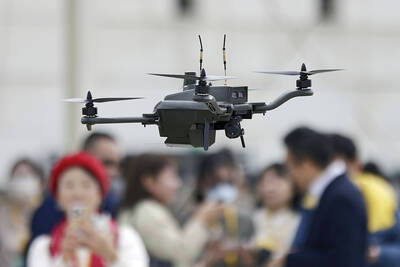The dollar advanced against the euro as traders said the decline after the US Federal Reserve lowered the target lending rate to near zero this week was too fast to be sustained.
The euro also weakened after the European Commission said the region may suffer a “substantial” effect from the financial crisis next year.
The yen traded near a 13-year high against the dollar, even after the Bank of Japan lowered its benchmark interest rate to 0.1 percent.
“This was the most concentrated, rapid rally in the euro since its creation,” said Robert Sinche, head of global currency strategy at Bank of America Corp in New York. “The market got a little ahead of itself in the short run. We are getting a healthy correction now.”
The dollar climbed 2.6 percent to US$1.3874 versus the euro at 12:01pm in New York, from US$1.4240 on Thursday, when it slumped to a 12-week low of US$1.4719.
The euro fell 2.5 percent to ¥124.28 from ¥127.44. The dollar traded at ¥89.48, compared with 89.43. It dropped to ¥87.14 two days ago, the lowest level since 1995.
The US currency declined 2.9 percent against the euro on Wednesday, the biggest drop since the 15-nation currency’s 1999 debut.
The nine-day relative strength index of the dollar versus the euro, a comparison of the magnitude of gains and losses, was at 21.44 yesterday, below the level of 30 that signals a change in direction may be imminent.
“This is not a fundamentally driven move in the euro,” said Lutz Karpowitz, a Frankfurt-based currency strategist at Commerzbank AG. “We have very low liquidity right now, and volatility is very high.”
Asian currencies gained this week, led by South Korea’s won and Malaysia’s ringgit, as a rally in regional stocks helped draw funds. The NT dollar jumped the most in a decade.
Eight of the 10 most-active Asian currencies outside Japan rose on speculation that US interest rates as low as zero are fueling demand for higher-yielding assets. The won, Asia’s worst performer this year, strengthened 14 percent this month. Hong Kong’s dollar was unchanged at the upper end of its fixed exchange-rate band.
“The dominant swing in emerging Asia currencies has been the shift away from the dollar,” said David Cohen, director of Asian forecasting at Action Economics in Singapore and a former Fed official.
The won strengthened 6.4 percent this week to 1,290 per dollar.
Malaysia’s ringgit had its best week since a peg to the dollar ended more than three years ago.
The ringgit rose 3.3 percent this week to 3.4687 per dollar and touched an 11-week high of 3.4390 in Kuala Lumpur yesterday.
The Philippine peso, which had its best week since July, weakened yesterday after the central bank cut its key interest rate on Dec. 18 by more than economists forecast.
Singapore’s dollar gained 2.7 percent this week to S$1.4537 against the US currency. The yuan slipped 0.1 percent to 6.8465.
The NT dollar climbed 2.4 percent this week to NT$32.53 per dollar, its biggest gain since October 1998, as overseas investors bought more local stocks than they sold.
The central bank intervened on Thursday to check the currency’s advance, the China Times said yesterday, citing traders.

FORCED LABOR: A US court listed three Taiwanese and nine firms based in Taiwan in its indictment, with eight of the companies registered at the same address Nine companies registered in Taiwan, as well as three Taiwanese, on Tuesday were named by the US Department of the Treasury’s Office of Foreign Assets Control (OFAC) as Specially Designated Nationals (SDNs) as a result of a US federal court indictment. The indictment unsealed at the federal court in Brooklyn, New York, said that Chen Zhi (陳志), a dual Cambodian-British national, is being indicted for fraud conspiracy, money laundering and overseeing Prince Holding Group’s forced-labor scam camps in Cambodia. At its peak, the company allegedly made US$30 million per day, court documents showed. The US government has seized Chen’s noncustodial wallet, which contains

SUPPLY CHAIN: Taiwan’s advantages in the drone industry include rapid production capacity that is independent of Chinese-made parts, the economic ministry said The Executive Yuan yesterday approved plans to invest NT$44.2 billion (US$1.44 billion) into domestic production of uncrewed aerial vehicles over the next six years, bringing Taiwan’s output value to more than NT$40 billion by 2030 and making the nation Asia’s democratic hub for the drone supply chain. The proposed budget has NT$33.8 billion in new allocations and NT$10.43 billion in existing funds, the Ministry of Economic Affairs said. Under the new development program, the public sector would purchase nearly 100,000 drones, of which 50,898 would be for civil and government use, while 48,750 would be for national defense, it said. The Ministry of

SENATE RECOMMENDATION: The National Defense Authorization Act encourages the US secretary of defense to invite Taiwan’s navy to participate in the exercises in Hawaii The US Senate on Thursday last week passed the National Defense Authorization Act (NDAA) for Fiscal Year 2026, which strongly encourages the US secretary of defense to invite Taiwan’s naval forces to participate in the Rim of the Pacific (RIMPAC) exercise, as well as allocating military aid of US$1 billion for Taiwan. The bill, which authorizes appropriations for the military activities of the US Department of Defense, military construction and other purposes, passed with 77 votes in support and 20 against. While the NDAA authorizes about US$925 billion of defense spending, the Central News Agency yesterday reported that an aide of US

UNITED: The other candidates congratulated Cheng on her win, saying they hoped the new chair could bring the party to victory in the elections next year and in 2028 Former Chinese Nationalist Party (KMT) lawmaker Cheng Li-wun (鄭麗文) yesterday won the party’s chair election with 65,122 votes, or 50.15 percent of the votes. It was the first time Cheng, 55, ran for the top KMT post, and she is the second woman to hold the post of chair, following Hung Hsiu-chu (洪秀柱), who served from 2016 to 2017. Cheng is to succeed incumbent Eric Chu (朱立倫) on Nov. 1 for a four-year term. Cheng said she has spoken with the other five candidates and pledged to maintain party unity, adding that the party would aim to win the elections next year and